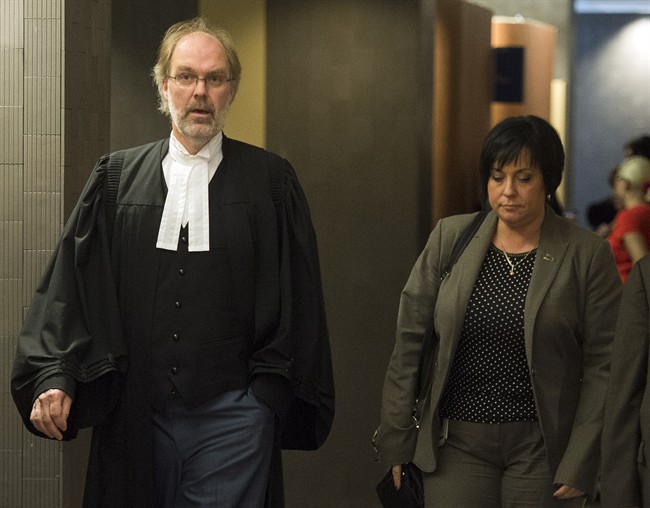MONTREAL — The Crown launched its cross-examination of a key defence witness Wednesday who has for more than three days repeated to the court her opinion that Luka Magnotta was in a state of psychosis and unaware of his actions when he killed Jun Lin.

Bouthillier was quick to point out that Magnotta has lied to health professionals: Taken to an emergency room in Miami in 2011, Magnotta told doctors he suffered no mental illness, even though he’d been treated for schizophrenia for years. Then, just weeks before killing Lin, Magnotta was referred to a psychiatrist at the Jewish General in Montreal. Again, he withheld critical information, neglecting to tell doctors he was hearing voices.
During one of their meetings, Magnotta told Allard he lied for fear of being hospitalized.
If Magnotta lied to those doctors to avoid hospitalization, Bouthillier asked Allard, could he also lie to avoid jail? The prosecutor then suggested Magnotta had no problems lying, going so far as to call the defendant a “pathological liar.”
Quebec Superior Court Justice Guy Cournoyer took issue with the prosecutor’s insinuation, and took it upon himself to remind the jury of a tenet of the Canadian justice system: the presumption of innocence.
READ MORE: Did Magnotta make up rumours about himself? What prompted him to mail packages to Ottawa?
Lying and diagnoses of schizophrenia do not go hand in hand, Allard told the court. “Lots of people lie,” she said, admitting it could at times be difficult to tell whether Magnotta was telling the truth.
Another question from the Crown: How did Lin react when Magnotta slit his throat? Allard said she didn’t ask.
Bouthillier continued: Why was Magnotta calmly, almost methodically, walking the halls of his apartment building to either go outside or to the basement garbage room?
He said he was confused, Allard said. Trying to find logic in the actions of someone with schizophrenia and suffering a psychotic break can be futile, she added. But, she said, one hypothesis could be Magnotta felt the threat was gone, now that he had killed who he said he believed was a government agent.
Defence counsel Luc Leclair hired Allard to assess Magnotta’s responsibility for the crimes of which he is accused. She had access to the video the defendant posted online depicting Lin’s dismemberment, read his medical files dating back to 2001, went through extensive witness testimony from preliminary hearings, and met with Magnotta for more than 23 hours over eight days beginning in December 2013.
READ MORE: Magnotta was convinced Lin was government agent sent to kill, according to psych report
Allard began her chief testimony last week, when she told the court Magnotta is schizophrenic, the illness was present the night he killed Lin and it is responsible for the actions that led to the five charges Magnotta now faces.
Magnotta is charged with first-degree murder, committing an indignity to a human body, publishing obscene material, criminally harassing Prime Minister Stephen Harper and other members of Parliament and mailing obscene and indecent material.
Bouthillier asked Allard why she didn’t talk to people who may have been around Magnotta in the days before the killing.
Allard said she tried, unsuccessfully, to reach some people, but there weren’t many to reach out to.
Does she know why Magnotta decided to post the video showing Lin’s dismemberment to a gore site? If he was concerned about the government, could he have sent the footage to the government? Allard didn’t have answers to these questions form the prosecution.
Nor had she asked Magnotta why he kept the baseball cap Lin wore the night he was killed, she said. Bouthillier wondered whether the cap was kept as a sort of trophy.
Allard presented another theory: Magnotta kept the cap as “evidence” of what had happened with the government.
“But you don’t know because you didn’t ask him,” Bouthillier said.
“No, I didn’t ask him,” Allard said back.
READ MORE: Luka Magnotta’s family doctor tells murder trial about accused hearing voices
The Crown’s cross-examination highlighted the defence witness’s reliance on Magnotta’s account of events.
Was she aware of differences between what Magnotta told her and what he told another psychiatrist who is also scheduled to testify for the defence? Allard said she became aware, but not prior to meeting and assessing the defendant. The court hasn’t yet laid out the differences in either report.
Allard acknowledged Magnotta didn’t provide details — only broad strokes —when recalling the killing and his actions before and after the killing.
But, she said, memories are fragile and the mind often protective. During traumatic, shameful or overwhelming times, the mind sometimes suppresses memories, she said.
The prosecutor also asked why Magnotta had bought paint at an art store the day after killing Lin, using it on the suitcase he later used to hold the victim’s dismembered torso.
IN DEPTH: Luka Magnotta trial
Allard said she was aware Magnotta had purchased the paint on May 25, 2012 but didn’t ask why.
“You don’t find it interesting that he went to the store to buy paint then painted and cut the suitcase?” Bouthillier asked before suggesting Magnotta had perhaps wanted to make the suitcase appear old so no one would take it off the street.
The defendant’s behavior with the suitcase is but one example Bouthillier suggested was calculating and deliberate — behaviours the prosecution is focused on highlighting to the jury.
With Magnotta’s plea of not criminally responsible due to mental illness, the jury is tasked with gauging the defendant’s state of mind at the time of the crime and determining whether Magnotta had the capacity to understand the gravity of his actions.




Comments